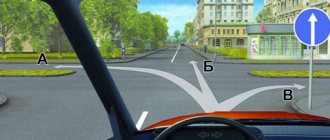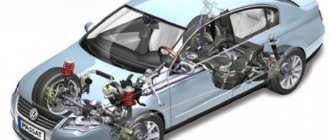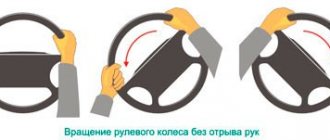Hi all! The issue of traffic rules has not been discussed for a long time. And then an unpleasant traffic situation arose, which prompted the idea to talk about the Narrowing of the road sign.
Many have seen it, but not everyone knows how to act correctly in a given situation. Moreover, we are talking specifically about a red triangular sign. There is also blue, which is often confused with narrowing. In fact, a similar blue sign means the end of the strip. If anyone is interested, we will discuss it in our separate article.
Today we focus on the signs of the 1.20 series. Let's try to find out how to pass on the left or right, who should give way and how to act if narrowing occurs on both sides.
What does the road narrowing sign mean and what does it look like?
Road narrowing belongs to the category of warning signs and is installed:
- In the city, according to traffic rules, it is installed at a distance of approximately 100 meters from the beginning of the site
- Outside the city on the highway at a distance of an average of 200 meters.
- Outside the populated area, it is re-installed 50 meters before the dangerous area.
Even people who graduated from driving school a long time ago and may have forgotten some traffic rules will understand it. After all, there is nothing complicated in its structure. The sign itself looks like a triangle with a red border and signals a decrease in the number of lanes and the need to change lanes.
If a road sign has an unusual yellow background, this means it is temporarily in this place and is installed in places where road work is being carried out. But there are times when the one established in this place and the temporary one contradict each other. In this situation, you should be guided by temporary signs.
Types of road narrowing sign
It has three different types:
- 1.20.1 - the road narrows both on the right and on the left,
- 1.20.2 - the road narrows on the right,
- 1.20.3 - the road narrows on the left.
They all look almost the same.
Signs warn the driver that one of the lanes will soon end and there is a need to change lanes. Usually the sign is also accompanied by markings on the road, but if there are none, you should pay more attention to the signs.
1.20.1 - narrowing of the road on both sides is much less common than 1.20.1 and 1.20.2. It happens that a three-lane road turns into a one-lane one. In this case, you need to be even more careful, because cars change lanes on both the right and left into one lane, and you will need to know who is giving way to whom when changing lanes.
This is interesting: Do-it-yourself car alarm repair
Varieties of sign
Here we are talking about signs 1.20, of which there are actually 3. And they have slightly different appearances, installed in appropriate situations. In the photo you can clearly see the difference.
The point of the sign is that two lanes merge into one. The only question is that there is an acceleration lane, and there is another narrowing lane. That is, they move straight along one, and perform a maneuver along the other. But there is an exception in the form of the third sign, where the maneuver is provided from two lanes at once, which begin to narrow. I think it is about this sign that the greatest number of disputes and conversations arise.
As for the signs themselves, they are presented in the form of a red triangle with a white background. The background can also be yellow, which means the sign is temporarily located in this area. They are installed during repair work.
When the repair is completed, the structure is removed and it ceases to function.
But the image inside the triangle comes in 3 types. Hence the division into subcategories of the sign.
- 1.20.1. Such an indicator is presented in the form of the same triangle, inside of which 2 black stripes narrow. From expansion begins contraction. This means that change occurs on both sides;
- 1.20.2. Here the left black stripe remains straight, and the right one is curved. I think it’s not difficult to understand that the narrowing occurs on the right side;
- 1.20.3. The situation is the opposite of the previous one. The left stripe is straight, and the right one tapers.
There are different signs on the roads. From them, the driver can understand in advance that there will be a narrowing ahead. Moreover, some motorists must change lanes or yield to other drivers, depending on where they are moving and in which lane.
This makes it possible to regulate the flow of cars on sections of roads that narrow.
The narrowing can be permanent or temporary. In the first case, the pointer will have a white background, and in the second, yellow.
Signs are located at a distance of 50 to 100 meters from the narrowing itself, if it is located within a populated area. Outside populated areas, according to the rules, the sign must be placed at least 150 and maximum 300 meters away.
There are also large cities where such signs are located specifically at public transport stops. According to traffic regulations, drivers do not have the right to enter there, since this is a designated area for public transport where passengers pick up and drop off. A smart solution for security purposes.
Lack of signs and markings
The situation is not uncommon when there is a narrowing, but it occurs without a sign or marking. This is a huge flaw in the responsible services.
If you doubt the correctness of your actions, if there are no signs and markings, just imagine that they are there. This will make it easier to make the right decision.
You should not rely on the fact that due to a missing sign you can violate the rules of the signs in question and the traffic priority rule if you are fined or you become the culprit of an accident. So, this may somewhat influence the court's decision. But at the same time, even the absence of a sign or markings does not relieve one from responsibility for failure to comply with the rules on the need to give way to passing vehicles that do not change their direction.
Subscribe to updates and receive articles by email!
We guarantee: no spam, only new articles once a week!
Good afternoon, dear car enthusiasts!
In this material we will consider the issue of priority when narrowing the road. With proper organization of traffic, the narrowing of the road is indicated by appropriate signs and markings, however, in practice, it is not uncommon for drivers to find themselves in a “neck” in the absence of means of organizing traffic.
For example, take the narrowing of the road at a bend.
Cars moving in two rows in the same direction are forced to divide the remaining lane among themselves. There are only two options, either the white car is inferior, or the blue one.
Basically, for this situation, drivers apply one of two points of the Rules of the Road.
Some people consider this a rebuild:
8.4. When changing lanes, the driver must give way to vehicles moving in the same direction without changing direction. When simultaneously changing lanes of vehicles moving in the same direction, the driver must give way to the vehicle on the right.
For others, this situation is not regulated by the rules and they apply clause 8.9 of the traffic rules:
8.9. In cases where the trajectory of vehicles intersect, and the order of passage is not specified by the Rules, the driver to whom the vehicle is approaching from the right must give way.
Arguments for gaining an advantage from a white car: “I’m moving in the left lane, there are no obstacles in this lane, I’m not maneuvering, I’m not changing lanes, the blue car is changing into the left lane.
Arguments for gaining an advantage for the blue car: “The road is narrowing, two lanes end, only one remains and both cars simultaneously change lanes into this remaining lane” or “In this case, the order of passage is not specified by the rules, and the one with the obstacle on the right gives way "
It turns out that both cars have the right to count on an advantage, but this cannot happen. Therefore, let's analyze this road situation in detail. First, for convenience, we will “straighten” the road, since the bend itself has no direct relationship to the number of lanes on the road. From the point of view of the Road Traffic Rules, driving along a curved road is straight. All direction changes are made relative to the direction of the road. The fact of narrowing is important, but the narrowing along the radius or along the straight line does not matter.
Travel rules
By default, all 3 “Road Narrowing” signs warn the vehicle owner about particularly dangerous areas. Usually, if a narrowing is planned, then a reduction in the number of lanes is also planned, and this is directly related to the implementation of lane changes, when priority rules are of great importance.
The mentioned group of signs is classified as a warning type: they do not regulate the primacy of traffic, here everything depends on the situation and the level of theory of drivers when crossing controversial areas.
Who must give way to a narrowing on the right or left
Here the matter directly concerns the parallel flow of cars that follow in the same direction on a flat section of the highway. When the route narrows to the left, then the standard condition works correctly. But where the arrow shows that the right lane needs to be shortened, then it is necessary to refer to the fact that the left lane is moving without interference, so you will have to slow down and try to enter from the left only if there is free space. In the case of heavy traffic, this maneuver risks taking a lot of time and effort, and there is no rush here.
Although the opposite cases are stipulated: when there is a congestion of cars in the coverage area of the sign “Narrowing of the road on the right” due to the impossibility of changing into the left lane, drivers moving in the adjacent lane can let other people’s cars pass. Moreover, quantitative control is excluded here: everything is decided primarily on the basis of driver solidarity.
If you see that there is a traffic jam on both sides, you should slow down and let several drivers pass in turn. In fact, this does not mean that you need to drive along the disappearing lane all the way in order to hope for the understanding of your colleagues. It is much more logical to check in advance whether there is an opportunity to join another lane more actively.
Bilateral narrowing
Much more problems arise when passing the sign in question, warning that further down the road there is a planned narrowing on both sides. Here it is much more difficult to decide who is obliged to let pass, and who is only to claim the right of priority during travel.
If the road has 3 lanes, then everything is clear: a person moving along the central road has no obstacles. And vehicles traveling in assembly are obliged to join the middle row whenever possible, giving way to drivers driving on a straight road. When there are only 2 lanes and there is a smooth merging of rows, not adjoining, then the “right hand” principle is already in effect: the driver on the left must give way.
Separately, it is necessary to mention situations where a narrowing of the road surface occurs in the absence of the necessary sign on the path. This rarely happens, especially within the city, but on a suburban highway, traffic police officers sometimes forget to install this temporary sign. Then a “neck” appears, sometimes simultaneously with the absence of the marking itself.
Here one should rely on a related rule, as if the sign were in fact - the lane where the congestion initially occurred should be perceived as disappearing. But often the application of these rules is impracticable due to the large concentration of cars and it is difficult to understand which lane should disappear before the car reaches the congestion site.
Who should give in if contraction is ahead?
Situations when a driver has to deal with this sign are described earlier in the article. But here's what you need to do if there is a planned narrowing of the road ahead and it is unclear who is obliged to give way during future maneuvers - the neighboring traffic or you?
As the injured party, it is worth remembering that this is not the fault of the passing traffic, which follows in the same direction at a standard speed of 60 km/h, and even faster outside the city. Therefore, traffic regulations state that one way or another the owner of a vehicle is obliged to give way to passing traffic (nearby cars in an adjacent direction).
However, you don’t have to wait until all the cars have passed along the specified road. If a traffic jam develops from the lane ahead, then they are also required to let through from the adjacent passing lane, guided by the same traffic regulations (only not all at once, but one car at a time).
There is a driving ethic where other road users try not to tightly occupy the lane that touches the narrowing zone so that other road users can change lanes in time. Sometimes this is not possible (for example, at intersections), so it is necessary to plan lane changes in advance.
Directions.
The Traffic Rules do not limit directions to driving straight ahead - this is important. There are four directions of movement:
- Directly
- Right
- Left
- Reverse direction
The next important point is that the direction of movement is determined relative to the direction of the road. If a road physically changes direction, then the direction of travel on that road does not change. Driving on a winding road is, within the framework of the Road Traffic Regulations, driving straight. For example, there is no need to turn on your turn signals, stay in an extreme position, or comply with other regulations related to maneuvering, because you drive straight regardless of changes in the actual direction of the road. You are moving along the road. Where the road goes, so do you.
Please note: In the text of the rules, the same concepts can be used both in the generally accepted understanding and in accordance with the definitions. For example:
A turn is a maneuver described in Chapter 8 of the rules as a change in the direction of movement on the roads and a turn in the generally accepted sense, indicated by the signs “Dangerous turn” or “dangerous turns”, as an actual change in the direction of movement.
Stopping is an action defined by the Rules of the Road, and an actual stop when the speed of movement becomes zero (in a traffic jam or in front of a traffic light). The same goes for directions.
Varieties and features of signs of this group
Warning sign 1.20 called “Narrowing of the road” can be found quite often, both within the city and on highways. One glance at the characteristic triangle is enough for even those ignorant of these matters to intuitively understand its meaning. There are three varieties of it:
- narrowing on both sides (1.20.1);
- narrowing on the right (1.20.2);
- narrowing on the left (1.20.3);
According to the rules, signs of this group are installed at a distance of 50 to 100 meters before the start of a dangerous section (if the road passes within the city) or within 150-300 meters (on country roads).
When is it okay not to give way?
You may not give way in the following cases:
- at an unregulated intersection when moving along the main road (except for pedestrians who have entered an unregulated pedestrian crossing);
- at a controlled intersection when moving on a green light in the forward direction (except for a tram, also moving on the main green light);
- at the intersection of equivalent roads if you intend to turn right (except for pedestrians) (there is no need to yield, since there is no obstacle on the right);
- when the road narrows, you do not need to yield if you continue to move in your lane without changing direction.
Cases when you may encounter this sign
Situations on the road are different. This sign can be found:
- in the city
- outside the populated area.
But it is quite difficult to find it in the city; it is usually replaced by road markings.
So, the main cases when you may encounter this sign:
- The sign is found in those places where one of the stripes ceases to exist. And it’s good if you know this section of the road and can change into the desired lane in advance, but for drivers who drive here for the first time, narrowing the road can cause a lot of trouble in the city. For example, you are driving through the city and see a narrowing road in front of you. You are faced with the need to change lanes, but there is a dense flow of cars in the adjacent lane, which does not give you room to maneuver. And you have to either slow down too much, or stop completely and wait until they let you pass or there is enough distance between the cars so that you can change lanes. But don't forget to turn on your turn signals when changing lanes.
- This sign can also be found at road work sites. As we said, its difference is the yellow background of the sign. In this case, the lane on the road is simply fenced off by road workers and it becomes temporarily inaccessible for traffic.
- The sign is installed in places where you exit from a minor road onto a wide highway or avenue.
- The sign can also be found before passing under a bridge, where the road usually narrows from several lanes in one direction to one lane.
Situations where there is no warning sign
There are also situations when there is no sign and the road narrows. What to do in this case? It's quite simple. You must follow other travel rules.
Considering that your lane is ending, when changing lanes you must give way to other cars moving without changing direction.
This is stated in rule 8.4, because when you change lanes into an adjacent lane, you will be an obstacle for other cars. And don't forget to turn on your turn signals to give advance warning of your maneuver.
This is interesting: What is the fine for driving on the sidewalk in 2022
What does the “Narrowing Road” sign look like and what does it mean?
- on right;
- left;
- at both sides.
Depending on the type of narrowing, a corresponding sign is installed to warn drivers that some of them, depending on their position on the road, will need to change lanes or give way to another car. This is necessary in order to maintain order on the road, so that drivers clearly know what to do and no dangerous emergency situations arise.
The narrowing itself can be temporary or permanent, depending on the situation. There are some areas where it was impossible, for one reason or another, to build an equally level road with a standard width. Therefore, such a sign is installed on a permanent basis in these areas. But, in most cases, such signs are installed temporarily on normal standard roads, for example, if repair work is underway there. Since it is not always possible to block all traffic on the road during repair work, only part of it is closed, one lane, and the other is left so that drivers can pass. And so that drivers know in advance that repair work is underway in this area and the road is narrowing, appropriate signs are installed. If the sign is temporary, it will be yellow.
In addition to installing a road sign “Narrowing of the road”, it is also necessary to install a sign notifying about road work. After the work is completed, both signs are removed.
If the sign is permanently installed, then in populated areas it is installed at a distance of 50-100 meters, outside populated areas - at a distance of 150-300 meters.
In large cities, such signs are located in areas where there are public transport stops. The signs are there permanently so that buses, trolleybuses, minibuses and other types of public transport can stop, disembark and pick up new passengers without interference. And ordinary cars will not interfere with them at this moment.
Features of the “Give Way” family signs
Like most other warning signs, signs indicating a narrowing of the roadway are triangular in shape with a white background and a wide red border around the perimeter. Inside the sign there are pictograms of two stripes. If the taper is on both sides, both stripes will be curved with a taper at the top. With a one-sided reduction, one of the stripes will be straight, and it will be located on the side where the narrowing is not expected. This designation is intuitive and means that if you are driving from a straight lane, you have the right of way because you are moving straight.
If the road narrows on the left side, this means that traffic moving along it will have to change lanes to the adjacent right lane, and vice versa. If a two-way narrowing is expected, both the left and right columns will have to change lanes to the central lane.
In any case, those drivers who are driving in the lane to which they need to change lanes have an advantage. In most cases, the interpretation of this family of signs does not cause ambiguous interpretation.
Varieties of the “Narrowing Road” sign
Fines for traffic violations
No one is immune from mistakes, including the rules for driving sections of the road where the sign “Narrowing of the road” is installed. Although in fact there is no need to talk about the level of punishment for the offenses in question: according to Article 12.014 of the Administrative Code, it implies the imposition of a fine of 500 rubles.
So far, this is not considered a significant incentive for drivers to unconditionally adhere to an acceptable queue in such controversial situations.
Is it possible to challenge a fine?
Modern drivers are often well-versed in legal terms and try to keep abreast of the latest innovations in legislation, so they easily provoke disputes with law enforcement officials who monitor compliance with traffic rules.
Experts recommend doing this only when the owner of the vehicle is absolutely sure that he is right. Since situations with “Narrowing of the road” signs are interpreted quite unambiguously, the chances of circumventing the penalties are minimal.
The traffic police officer has the right not to report at all that the violation was recorded by specific technical means, and the driver himself runs a great risk by filing an appeal. Therefore, it is much more effective to admit this violation, because it implies a small fine and is subject to the law of a 50% discount provided payment is made within 10 days.
| Did not find an answer to your question? Call a lawyer! Moscow: +7 (499) 755-83-41 St. Petersburg: +7 (812) 917-23-31 |
In general, the “Narrowing Road” family of signs rarely causes serious problems among drivers. Poor knowledge of the rules regarding these signs risks creating long-term traffic jams on the problem section of the highway. But with proper skill and compliance with ethics among drivers, you can avoid emergency situations and more serious violations.
Tapering options
The driver’s actions in a situation with the signs in question directly depend on which side the narrowing will occur.
- If the situation narrows on the right, that is, the right lane on the sign is curved, then those moving along this lane, that is, on the right, are required to change lanes. They should carefully move to the left;
- If the narrowing is on the left, then on the contrary they will have to go to the right;
- When the situation forces you to narrow on both sides at once, the transition is simply to the middle lane.
During the maneuver you should be extremely careful and careful. Are you moving from your lane to the next one? Then it is the adjacent lane that is now the main one, and you must give way to drivers moving along it.
If, in accordance with the sign, your lane does not narrow, but the neighboring one does, then you must be allowed to pass on the left or right, depending on the type of sign installed.
Bilateral narrowing involves the use of the same rules and principles. Whose streak ends first is the one who misses.
How to avoid an accident on a narrowing road
In places where the road narrows, there is always the possibility of a side collision with a fellow traveler who is driving parallel in the next lane or in the next row.
To avoid getting into an accident where the roadway narrows, you should look at the road several cars ahead and prepare to change lanes in advance, monitoring the situation around your car. Most often, the road narrows on the right side, but if road work is underway on the roadway, it can be narrowed on any side of this direction.
In road construction sites, side barriers are often installed in narrow areas. Therefore, in order to avoid an accident, it makes sense not to accelerate at the entrance to such a site.
The “End of lane” sign is usually visible from afar, and “Narrowing of the road” warning signs are installed in advance (outside the populated area 150-300 meters, in the populated area - 50-100 meters before the narrowing). Therefore, it is possible to get your bearings in advance.
The method of changing lanes (early or late) will have to be chosen, as they say, during the movement, depending on the traffic density of cars that will develop at that moment in time.
If you are moving next to a lane that is narrowing or ending, then you need to carefully monitor the “neighbors” who have begun to change lanes. It happens that the process of rebuilding them begins late, and happens roughly, as if forcing fellow travelers to slow down and let them into their lane.
For this reason, it makes sense to constantly monitor the lateral interval to the cars next to you, and be prepared, if something happens, to take measures to prevent an accident (use a sound signal, brakes to help).
In such cases, there is no universal advice on what to do. Each specific situation has its own “nuances”. But you can only see them by monitoring the situation around your car.
Rules for such a maneuver
The procedure for simultaneous and single changes of cars from row to row is regulated by paragraph 8.4 of the traffic rules.
It contains the following requirements.
- If a car is driving in the right lane and wants to continue driving in the left lane, the driver must make sure that his maneuver is safe and turn on the appropriate turn direction indicator light. Moreover, if another car is driving on the left (interference on the left), then it has priority. It follows from this that the obstacle on the left must be passed forward, and only after that, after making sure it is safe, carry out the above maneuver.
- If a car is moving in the left lane and wants to change lanes (make a maneuver) to the right lane, then the driver must turn on the turn signal and make sure that there is no obstacle on the right (another vehicle), and then move. In this case, the car that is driving in the other lane (obstacle on the right) has the advantage, so you need to let it pass, and then just carry out the maneuver.
Such rules are established so that you can safely change lanes. This is not a difficult maneuver, but it requires maximum attention from the driver and the choice of a certain speed limit.
In addition, drivers must carefully monitor the road situation and choose the optimal speed limit. That is, even if someone violates traffic rules and creates an emergency situation, they should try to avoid an accident by correct maneuvering.
Interference on the right when turning and driving through intersections
At the exit from large populated areas, as well as in the center of some smaller urban areas, unregulated intersections are very common. There are 2 types of them: unequal and equivalent intersections. But how should we proceed in this case?
Equivalent intersections
The driver of a trackless vehicle, in this case, can fully use the right-hand rule, having previously let the rail vehicle pass. The obstacle on the right when turning is taken into account by all traffic participants in this section. We have previously written in detail about the passage of vehicles at unregulated intersections.
Uneven intersections
For convenience and correct passage, you should first study the road signs when approaching the junction. The first to leave such a section are the rail workers located on the main road. Next are trackless vehicles that are on the main road (when crossing, we use the right-hand rule). Only then can participants on the secondary road pass each other in the same order (first rail vehicles, then trackless vehicles).
Legal assistance in case of violations and accidents
Road disputes are one of the most common today; drivers often get confused due to the installation of contradictory signs, misunderstand the rules and find themselves in difficult situations due to a number of additional nuances. As practice shows, all cases are individual and therefore require detailed consideration from a legal point of view. Therefore, if you get into an accident or disagree with a traffic police officer who has accused you of a violation, it would not be a bad idea to seek help from a lawyer specializing in motor vehicle law issues. He will help you understand the situation and find the right way to resolve the issue.
Installing a Chinese din radio in a car: how to do it yourself
But sometimes changes in the width of the road surface on the right or left force you to wait for a long time, allowing motorists to pass in the priority lane. If it is a busy highway with huge traffic jams, according to the rules you will still have to wait. But there is a concept of driver ethics. It provides that the driver can stop, letting cars pass from the narrowing lane, in order to relieve the situation a little. If you are missed in a heavy traffic, don’t forget to say thank you. This is done extremely simply by turning on the emergency lights for a few seconds.
I think there is nothing complicated here. Those who remain in their lane calmly continue moving, do not wait for anyone and do not let anyone through.
When there is a narrowing in your lane, you wait and let it pass. Everything is elementary.
Who must give way if there is a narrowing on the right?
The problem of the question for many is due to the fact that drivers are accustomed to being guided by the principle of the “right” hand, but here we should not forget that the rule “Interference on the right” applies exclusively to intersections, but does not apply in any way to those who are moving parallel, in the same direction in a straight line road surface. Thus, a car that finds itself in the right lane, which, according to the sign, will disappear in a few meters, needs to slow down and let the passing traffic pass, which is absolutely not to blame for the problem that has arisen with your row.
At the same time, such a requirement does not mean that cars that find themselves on a “disappearing” road will have to wait indefinitely until the entire flow of cars in the adjacent lane ends. The rules of the road apply when, as soon as congestion begins to form on the narrowing side, drivers moving in the remaining lane must allow neighboring cars into their lane. Of course, not all at once, but one by one.
Carefully! Often, drivers, not wanting to waste time, move along the narrowing lane until the last meters, and then get stuck waiting for a long time, trying to fit into the next row. You should not rely only on the Rules and driving ethics; it is better to change lanes in advance.











